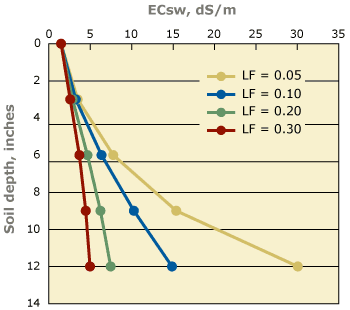- Home
- Learn about salinity
- Get to know your site
- Design a landscape
- Solve a problem
- Other information
Salinity Management Guide
Managing soil salinity
Management option: Increase the leaching fraction (LF)

Figure 10. Salinity profiles for the root zone of a turfgrass irrigated with ECiw of 1.5 dS/m, for LF of 0.05, 0.10, 0.20, or 0.30 (four different curves)
Recall that the leaching fraction, LF, is the ratio of the depth of drainage to the depth of applied water, assuming no runoff of applied water. Recall, also, that the salinity of soil in the root zone can be reduced by increasing LF. We illustrate this idea by examining a simple hypothetical situation. Figure 10 displays the distribution of salt in the root zone of a turfgrass irrigated with water of EC 1.5 dS/m. The annual ET is assumed to be 41.9 inches and the root-water extraction pattern over a 12-inch rooting depth is assumed to be 60-25-10-5 — in other words, 60% of the ET is extracted from 0–3 inch depth, 25% from 3–6 inch depth, 10% from 6–9 inch depth, and 5% from 9–12 inch depth.
At all depths, (0, 3, 6, or 9 inches), ECsw decreases as LF increases. For example, the curve that represents LF of 0.10 is at lower ECsw at all depths than the curve for LF of 0.05. Likewise, the curve for LF of 0.20 is at lower ECsw than for LF 0.10, and the curve for LF of 0.30 is everywhere lowest of all.
By looking at the curves, you can see that for this irrigation example an LF of 0.05 or 0.10 results in soil salinity that is too high for many turfgrasses. Increasing the LF to 0.2 and 0.3 reduces the salt accumulation in the root zone. Either of those leaching fractions would provide adequate leaching, even for salt sensitive turfgrasses.
| « Previous page | Next page » |